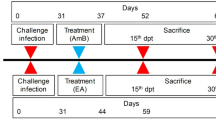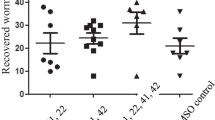Abstract
A compound of the coumarin class, 4-methyl-7-(tetradecanoyl)-2H-1-benzopyran-2-one, was evaluated for antifilarial activity against the human filarial parasite, Brugia malayi (sub-periodic strain) in Mastomys coucha. The test compound brought about a 24.4% reduction in circulating microfilaremia on day 8 after initiation of treatment when administered by the peritoneal route at a dose of 50 mg/kg for 5 consecutive days. The compound also caused a 62.0% mortality in adult parasites. Apart from killing adult filariids, it also brought about sterilization of 81.8% of the surviving female B. malayi. An oral dose of 200 mg/kg for 5 consecutive days was less effective (35.5% adulticidal efficacy and 65.8% sterilization). In vitro, the compound killed adult B. malayi at 100 μM concentration and inhibited DNA topoisomerase II activity in the filarial parasite. Studies are in progress using the compound in combination with standard antifilarials as well as other active agents.




Similar content being viewed by others
References
Casley-Smith JR, Casley-Smith JR (1992) Effect of various combinations of complex physical therapy, benzopyrones and mercury compression on lymphoedema—which combination works best? Excerpta Med Int Congr Ser 994:537–538
Casley-Smith JR, Jamal S, Casley-Smith JR (1993) Reduction of filarial lymphoedema and elephantiasis by 5, 6-benzo-5-pyrone (coumarin), and the effect of diethylcarbamazine (DEC). Am J Trop Med Hyg 87:247–258
Lowry OH, Rosenbrough NJ, Farr AL, Randall RL (1951) Protein estimation with Folin-phenol reagent. J Biol Chem 193:265–275
Michael E, Bundy DAP, Grenfall BT (1996) Reassessing the global prevalence and distribution of lymphatic filariasis. Parasitology 112:409–428
Misra S, Chatterjee RK, Sen AB (1984) The response of Litomosoides carinii to antifilarial agents in cotton rat Sigmodon hispidus and multimammate rat (Mastomys natalensis). Indian J Med Res 79:749–752
Mukherjee M, Misra S, Chatterjee RK (1997) Optimization of test conditions for development of MTT as in vitro screen. Indian J Exp Biol 35:73–76
Mukherjee M, Misra S, Chatterjee RK (1998) Development of in vitro screening system for assessment of antifilarial activity of compounds. Acta Trop 70:251–255
Otteson EA (1994) The human filariasis: new understandings, new therapeutic strategies. Curr Opin Infect Dis 7:550–558
Otteson EA, Duke BOL, Karam M, Behbehani K (1997) Strategies and tools for the control elimination of lymphatic filariasis. Bull World Health Organ 75:491–503
Pandya U, Saxena JK, Kaul SM, Murthy PK, Chatterjee RK, Tripathi RP, Bhaduri AP, Shukla OP (1999) DNA topoisomerases of filarial parasites: effect of antifilarial compounds. Med Sci Res 27:103–106
Singh U, Misra S, Murthy PK, Katiyar JC, Agrawal A, Sircar AR (1997) Immunoreactive molecules of Brugia malayi and their diagnostic potential. Serodiag Immunother Infect Dis 8:207–212
Tripathi RP, Tripathi R, Bhaduri AP, Singh SN, Chatterjee RK, Murthy PK (2000) Antifilarial activity of some 2H-1-benzopyran-2-ones (coumarins). Acta Trop 76: 101–106
Tripathi RP, Saxena JK, Shukla OP, Chandra S, Murthy PK, Bhattacharya S, Kamboj KK, Dwivedi AK, Chatterjee RK, Singh S, Srivastava VML, Rastogi AK, Bhaduri AP (2001) A process for the preparation of novel 4-alkyl-7-0-(acetamid-2-yl)-2H-1-benzopyran-2-ones useful as inhibitors of helminthic and protozoan DNA topoisomerases. Indian Patent Application 620/DEL/01
Acknowledgements
The authors gratefully acknowledge the constant encouragement and support given by Director, CDRI, Lucknow during the study. We thank Mr. S.K. Mandal for statistical analysis of data. Thanks are also due to Mr. A.K. Roy and Mr. R.N. Lal for their skillful technical assistance. The CDRI communication number allotted to this manuscript is 6294.
Author information
Authors and Affiliations
Corresponding author
Rights and permissions
About this article
Cite this article
Misra-Bhattacharya, S., Katiyar, D., Bajpai, P. et al. 4-Methyl-7-(tetradecanoyl)-2H-1-benzopyran-2-one: a novel DNA topoisomerase II inhibitor with adulticidal and embryostatic activity against sub-periodic Brugia malayi . Parasitol Res 92, 177–182 (2004). https://doi.org/10.1007/s00436-003-1014-3
Received:
Accepted:
Published:
Issue Date:
DOI: https://doi.org/10.1007/s00436-003-1014-3




